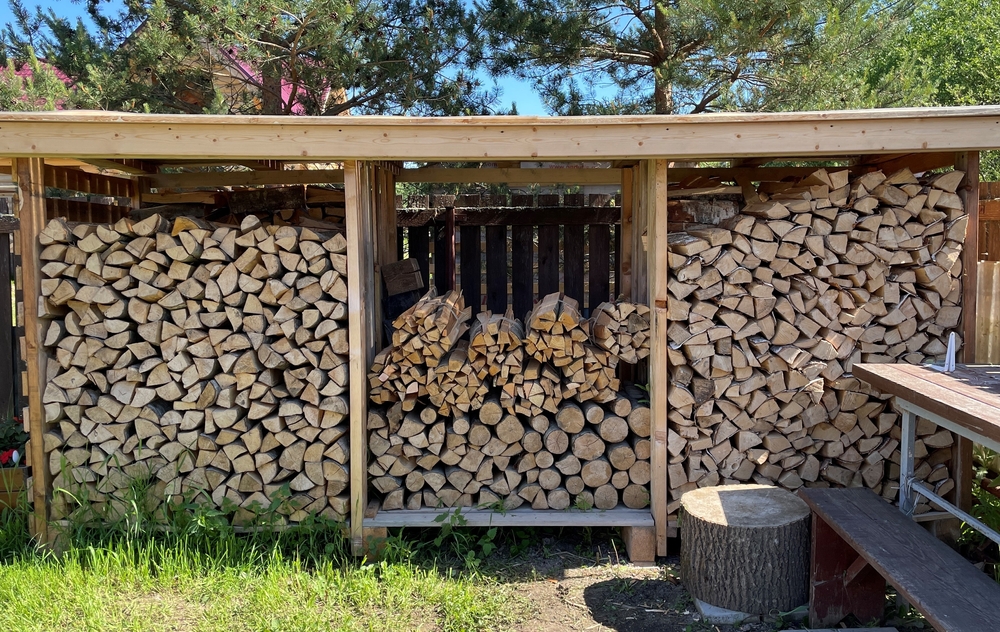How to Properly Store Firewood to Keep it Dry in Winter

As winter approaches, one of the key tasks for those relying on wood-burning stoves or fireplaces is to ensure they have a ready supply of dry firewood. Nothing is worse than reaching for your firewood only to find it damp and ineffective. Storing firewood in the winter properly is essential for maintaining a consistent and efficient heat source throughout the colder months. This guide will walk you through the best methods for storing firewood to ensure it stays dry, safe, and ready to burn.
Why Proper Firewood Storage is Important
Storing firewood improperly can lead to numerous problems. Wet wood produces more smoke, less heat, and can cause creosote build-up in your chimney, which is a potential fire hazard. Additionally, damp or improperly stored wood can rot, attract pests like termites and rodents, or even grow mold.
Benefits of properly storing firewood in winter include:
- Maximized heat output: Dry wood burns more efficiently, providing more warmth.
- Reduced creosote build-up: Dry wood produces less smoke and reduces chimney-related hazards.
- Longevity of wood: Proper storage prevents rot and decay, allowing you to keep firewood in good condition for longer.
- Pest control: Well-stored wood minimizes the risk of attracting unwanted insects and animals.
Types of Firewood That Store Well
Before we dive into storage techniques, it’s worth noting that not all wood types are created equal when it comes to burning. The type of firewood you choose plays a significant role in how well it will perform and store over time.
Hardwoods vs. Softwoods
Hardwoods like oak, maple, and hickory are denser, meaning they contain more energy and burn longer than softwoods like pine or spruce. Hardwoods are typically the better choice for long winter burns, as they provide more heat and tend to store better over long periods.
Key characteristics of well-storing hardwoods:
- They burn longer and hotter.
- They are less prone to sap and resin leaks, which can make storage messy.
- They dry out and remain usable for extended periods when stored correctly.
Softwoods, on the other hand, dry out faster and ignite easily, making them ideal for kindling. However, they tend to burn quickly and don’t store as well over long periods.
Best Practices for Storing Firewood in the Winter
1. Choose the Right Location
Location is one of the most critical factors in storing firewood in the winter. Ideally, firewood should be stored in a place where it can stay dry while also getting sufficient airflow to allow any moisture to escape.
Ideal locations for firewood storage include:
- A covered outdoor shed
- Against the side of your house, under a protective awning
- A raised firewood rack in your yard, covered with a tarp
2. Keep Firewood Off the Ground
Storing firewood directly on the ground is a common mistake. The ground absorbs moisture from rain, snow, and frost, which can seep into your woodpile, leading to mold, rot, and pest infestation.
Tips for elevating firewood:
- Use a firewood rack or wooden pallets to raise the wood off the ground.
- Create a foundation with large stones or bricks if a rack is unavailable.
- Ensure the wood is at least 4-6 inches off the ground to promote good airflow underneath.
3. Stack Firewood Properly
How you stack your firewood can also affect how well it stays dry during winter. A well-stacked woodpile allows air to circulate freely between the logs, which helps moisture escape and keeps the wood dry.
Proper firewood stacking tips:
- Stack logs in rows with the cut ends facing outwards.
- Leave some space between rows to allow airflow.
- Avoid stacking firewood against walls or fences without leaving space for air circulation.
- Keep the top layer slightly sloped to allow rainwater or snow to run off, instead of pooling on top of the pile.
4. Cover the Firewood
While it’s essential to keep firewood exposed to air, it’s equally important to protect it from direct exposure to rain or snow. Covering your firewood can prevent moisture from settling into the pile while still allowing air to flow.
Best methods for covering firewood:
- Use a weatherproof tarp to cover the top of your woodpile. Ensure that the sides are open to promote airflow.
- If you have a firewood rack, invest in a rack cover, which is designed to keep the top dry while allowing airflow from underneath.
- Ensure that the cover extends over the woodpile without being tucked in tightly, as this could trap moisture inside.
5. Store Firewood Close to Your Home (But Not Too Close)
It’s convenient to store firewood close to your home during the winter, especially if snow and ice make frequent trips to the woodpile difficult. However, storing firewood directly against the side of your house can lead to issues like moisture buildup, insect infestations, and even fire hazards.
Safe distance for storing firewood near your home:
- Store firewood at least 20-30 feet away from your home’s foundation.
- If storing closer, ensure the pile is raised, stacked properly, and covered to prevent moisture from seeping into the foundation or walls.
- Keep the firewood at least 5 feet away from your home to reduce the risk of pests or accidental fires.
6. Rotate Your Firewood
If you’ve been stockpiling firewood for a while, make sure to use the older wood first. Seasoned wood that has had more time to dry will burn better than freshly cut or unseasoned wood. Rotating your woodpile ensures that older, drier wood is used before it starts to degrade.
How to rotate your woodpile effectively:
- Use a “first in, first out” system, where older wood is positioned towards the front of the pile.
- Whenever you add new wood to the pile, place it behind or underneath the older logs to maintain a consistent rotation.
Firewood Storage Mistakes to Avoid
There are some common mistakes people make when storing firewood in the winter. Avoiding these can save you a lot of hassle and help ensure your wood stays in optimal condition.
1. Storing Firewood Inside
While it might seem like a good idea to store firewood inside your home to keep it dry, it’s generally not recommended. Storing large amounts of firewood indoors can invite pests, mold, and excess moisture into your home.
Why storing firewood indoors is not ideal:
- Firewood often harbors insects, which can become a problem indoors.
- Indoor storage doesn’t allow for sufficient airflow, causing the wood to retain moisture.
- Mold and mildew can develop if the wood isn’t properly seasoned or dry.
2. Covering the Entire Woodpile
It’s tempting to completely wrap your firewood pile in a tarp during the winter to keep it dry, but this can actually do more harm than good. Fully covering the wood traps moisture and prevents airflow, leading to mold and decay.
What to do instead:
- Only cover the top of the woodpile, leaving the sides open for ventilation.
- Ensure the tarp or cover is angled to allow water to run off, not pool.
3. Ignoring the Woodpile for Long Periods
Firewood requires occasional attention, even after it’s been properly stored. Check your woodpile regularly during the winter to ensure it remains dry, covered, and free from pests.
Maintenance tips:
- After a heavy snowfall, clear snow from the top of the pile and ensure the cover is still in place.
- Check for signs of pests or mold and remove any affected wood to prevent it from spreading.
- Ensure air is circulating properly by occasionally adjusting the cover or rearranging the pile.
How to Know If Your Firewood Is Dry and Ready to Burn
Properly seasoned firewood is key to efficient burning. But how do you know if your firewood is truly dry enough?
Signs of Dry, Ready-to-Burn Firewood:
- Cracking at the ends: Dry firewood typically has visible cracks at the ends of the logs.
- Lightweight feel: Dry firewood is significantly lighter than freshly cut wood.
- Hollow sound when hit: When two dry logs are hit together, they produce a clear, hollow sound, while wet logs sound dull.
- Moisture content: Ideally, firewood should have a moisture content of 20% or lower. You can use a moisture meter to test this.
Conclusion
Storing firewood in the winter is a crucial task that requires a bit of planning and effort. By choosing the right location, elevating and stacking your wood properly, covering it effectively, and rotating your stock, you can ensure a steady supply of dry, seasoned firewood throughout the cold months. Avoiding common mistakes like indoor storage and covering the entire pile will also help maintain the quality of your wood. With the right storage techniques, your firewood will be ready to burn, providing warmth and comfort all winter long.
Need Firewood in Lubbock, TX?
Here at Freedom Firewood in Lubbock, Texas, we take pride in offering a diverse selection of premium, fully seasoned, and ready-to-burn firewood to meet all your needs. Whether you’re looking for oak, hickory, mesquite, pecan, New Mexico pine, pinion pine, or a mixed variety, we have you covered. From one cord to a quarter cord, apartment stacks, and even convenient pre-bagged firewood, we provide the right quantity for you. Plus, with our local and long-distance delivery services, getting your firewood has never been easier. Contact us today to experience the warmth and quality of Freedom Firewood!
